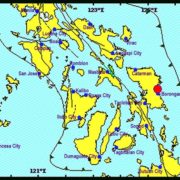
At 1:37 pm on April 23, 2019, Tuesday, a strong earthquake of Magnitude 6.5 shook the island of Samar and vicinity. The epicenter is located 9 kilometers northwest of San Julian, Eastern Samar at a depth of 65 kilometers. Small-magnitude earthquakes followed afterwards. As of 6 pm of April 23, 2019, 37 aftershocks have been recorded by the PHIVOLCS-DOST seismic monitoring network.
Based on preliminary intensity reports, the strongest ground shaking was felt at PHIVOLCS Earthquake Intensity Scale (PEIS) VI (Very Strong) in San Julian in Eastern Samar. Intensity V (Strong) was felt in Tacloban City, Palo and Pastrana in Leyte; Catbalogan City in Samar; General McArthur, Salcedo and Guiuan in Eastern Samar; Catarman in Northern Samar and Naval in Biliran. Intensity IV (Moderately Strong) was felt in Sorsogon City; Naga City in Camarines Sur; Iloilo City; Bislig City in Surigao del Sur; San Francisco in Southern Leyte; Abuyog, Hilongos, Javier, Capoocan, Julieta, Baybay, Barogo, Jaro, McArthur, Matalum, Villaba in Leyte and Panganiban, Catanduanes. Furthermore, Intensity III (Weak) was felt in Binalbagan in Negros Occidental; Cabalian in Southern Leyte; Dimasalang in Masbate; Butuan City and Cabadbaran City in Agusan del Norte. Intensity II (Slightly Felt) was felt in Bago City and Bacolod City in Negros Occidental. The strong ground shaking near the epicentral area resulted to damages to some buildings and infrastructure.
Have strong to major earthquakes affected Samar Island in the past?
At least 24 onshore moderate earthquakes occurred in the Samar Island in the past. Earthquakes ranging from M5.0 to M6.8 and maximum Intensity VI ground shaking was generated in the region from 1907 to 2016 based on SEASEE Report and PHIVOLCS Earthquake Catalog. In 2012, an offshore major earthquake with M7.6 struck east of Samar Island that generated a maximum Intensity VII was felt in Guiuan, Oras, Sulat and Borongan City, Eastern Samar. Likewise, two M7.0 earthquakes struck east of Samar Island in 1995 and 1996.
Why do earthquakes occur in Samar Island?
Earthquakes in Samar are generated by the movement of the active faults which includes the Central Samar Fault, Eastern Samar Fault and Salcedo Fault and subdusubduction (diving) of the Philippine Sea Plate along the Philippine Trench. In addition, there are other nearby local faults, which may not be manifested on the surface, and may be sources of small to moderate-magnitude earthquakes.
What was the cause of the M6.5 earthquake?
The M6.5 Eastern Samar Earthquake was caused by the movement along the Philippine Trench. subduction (diving) of the Philippine Sea Plate along the Philippine Trench.
What can we expect from the current earthquake activity?
The current seismic trend indicates that the Magnitude 6.5 earthquake on April 23, 2019 is the main shock, which caused the strong ground shaking.
The succeeding small-magnitude earthquakes are the aftershocks. The aftershocks may continue to occur for several days, some of which may be felt.
Although the occurrence of an earthquake higher than Magnitude 6.5 cannot be discounted, its occurrence from the same source area is low.
Aside from strong ground shaking, what other seismic hazards are life-threatening?
Landslides, rock falls, and other types of mass movements may occur in mountainous or hilly areas. Liquefaction, manifested by sand boils or lateral spread may affect low-lying, water-saturated, sandy areas near the banks of rivers. Tsunamis may be generated by large offshore magnitude earthquakes or by submarine landslides.
Did the earthquake trigger a tsunami?
No. While the associated earthquake generator was the subducting slab along the Philippine Trench, the epicenter was onland.
What should be done by the affected communities?
People are reminded to be cautious of structures visibly weakened or with signs of damage by the 23 April 2019 earthquake, as these may be further damaged by aftershocks. In case of houses and other buildings with visible damage, it is best to contact the Municipal/City Engineering Office for advice. Engineers from the local government, other agencies and organizations should inspect buildings and other infrastructures to determine their integrity, and recommend appropriate actions to concerned affected groups or individuals.
Slopes should be checked for tension/incipient cracks that may have resulted from the strong ground shaking. Tension cracks may render slopes more susceptible to landslides. These areas should be avoided.
The best course of action is preparedness. In case of another felt earthquake, it is recommended that people protect themselves by doing the “drop, cover and hold”. In homes and offices, heavy furniture should be strapped to the walls, and appliances be secured to prevent them from toppling and causing injuries injury to persons. For offshore earthquakes capable of generating tsunami, coastal communities are advised to immediately evacuate to higher grounds or to farther inland as specified in their local tsunami evacuation plans.
What is the role of DOST-PHIVOLCS?
DOST-PHIVOLCS operates and maintains a network of 101 seismic stations spread across the Philippines. Data from the seismic stations are used to determine the location, magnitude and other characteristics of the earthquakes generated.
The closest seismic stations to Eastern Samar are the staff-controlled Palo Seismic Station in Leyte, and remote-telemetered seismic stations in Borongan, Eastern Samar, Catarman, Northern Samar and Ormoc City, Leyte.
Aside from monitoring the occurrences of earthquakes, PHIVOLCS also conducts hazards analyses and assessments; information, education and communication campaigns to the public. PHIVOLCS works hand-in-hand with other government agencies in mitigating the damaging effects of earthquakes.
—
For earthquake bulletins, volcano updates, hazard maps, and other information on earthquakes and volcanoes please visit their website at http://www.phivolcs.dost.gov.ph, and their Facebook and Twitter accounts. Earthquake observations may also be reported to PHIVOLCS at telephone numbers (02) 929-9254 and (02) 426-1468 to 79, local 124 and 125. (DOST-PHIVOLCS)






